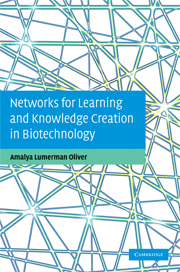Book contents
- Frontmatter
- Contents
- List of figures
- List of tables
- Acknowledgements
- Introduction
- 1 Networks, collaborations, and learning and knowledge creation
- 2 The biotechnology industry through the lenses of organizational and networks scholarship
- 3 New organizational forms for knowledge creation in biotechnology
- 4 Scientific entrepreneurship
- 5 Science and discoveries in the context of private and public knowledge creation and learning
- 6 The search for university–industry collaborations: linear and chaotic networking processes
- 7 Trust in collaborations and the social structure of academic research
- 8 Organizational learning and strategic alliances: recombination and duality of competition and collaboration
- 9 Further directions for understanding interorganizational collaborations and learning
- References
- Index
4 - Scientific entrepreneurship
Published online by Cambridge University Press: 04 July 2009
- Frontmatter
- Contents
- List of figures
- List of tables
- Acknowledgements
- Introduction
- 1 Networks, collaborations, and learning and knowledge creation
- 2 The biotechnology industry through the lenses of organizational and networks scholarship
- 3 New organizational forms for knowledge creation in biotechnology
- 4 Scientific entrepreneurship
- 5 Science and discoveries in the context of private and public knowledge creation and learning
- 6 The search for university–industry collaborations: linear and chaotic networking processes
- 7 Trust in collaborations and the social structure of academic research
- 8 Organizational learning and strategic alliances: recombination and duality of competition and collaboration
- 9 Further directions for understanding interorganizational collaborations and learning
- References
- Index
Summary
In order to have a full understanding of the arena of scientific technological innovation in general, and of biotechnology in particular, we have to place the role of basic research conducted in universities in context. Recent literature on national systems of innovation depicts intensive scientific collaborations between universities, industrial organizations, and government agencies (Etzkowitz & Leydesdorff 2000; Etzkowitz et al. 2000), and argues that university research may increasingly function as a locus of national knowledge-intensive networks. In addition, Hicks and Katz (1997) found that research in general is becoming more interdisciplinary and that research is increasingly conducted more in networks, both domestic and international.
At the same time, research on structural and procedural changes within universities raises the issue of the “second revolution” of universities. “The first academic revolution was the transformation of universities from institutions of cultural preservation to institutions for the creation of new knowledge. Putting that knowledge into use followed soon after. The second academic revolution was the translation of research into products and into new enterprises” (Etzkowitz & Webster 1998). This “second revolution” is based on large funding from the pharmaceutical industry, or smaller but more extensive precompetitive and contract research collaboration that industry and academia share.
These interinstitutional collaborations are coupled with the growth of commercialization of academic science and the translation of research findings into intellectual property (patents) – a marketable commodity (Djerassi 1993; Etzkowitz 1998; Etzkowitz & Webster 1998; Kleinman 1998; Lee 1996; Packer & Webster 1996).
- Type
- Chapter
- Information
- Publisher: Cambridge University PressPrint publication year: 2009



